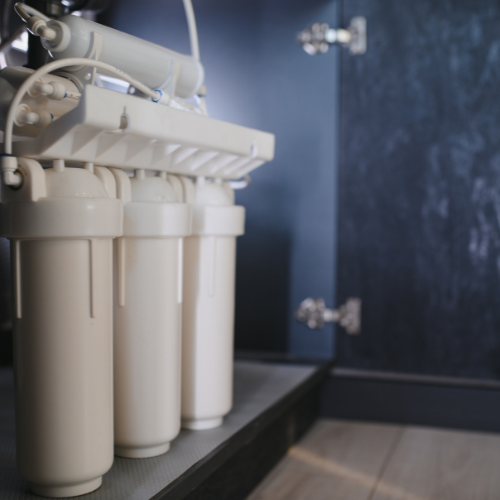Pure, Great-Tasting Drinking Water for the RGV
Reverse Osmosis Systems — Under-Sink & Whole-Home Drinking Stations
Treviño Repairs installs and services reverse osmosis (RO) systems that deliver clean, refreshing water at your kitchen sink—and to your fridge/ice—without the hassle of bottles. We size the system for your water pressure and usage, set up proper air-gap drainage, and offer options like remineralization, tankless RO, permeate/booster pumps, and UV add-ons (when appropriate)—all with neat, code-compliant plumbing for your Rio Grande Valley home or business.

Right System, Clean Install—RGV Wide
Services for Reverse Osmosis Systems
We design RO solutions around your goals (taste, coffee/tea, baby formula, ice clarity) and plumbing layout. After a quick water/pressure review (and lab testing if desired), we recommend the right configuration and perform a tidy install with labeled shutoffs and simple maintenance.
We install & replace:
- Under-sink RO (3–5+ stages), tank or tankless high-flow
- Remineralization cartridges for balanced taste/pH
- Booster pumps for low pressure; permeate pumps for better efficiency
- Dedicated RO faucets (air-gap/non-air-gap) and fridge/ice feeds
- Post-RO UV (when indicated, e.g., select well applications)
- Filter/membrane changes, sanitization, leak diagnostics, TDS checks
Code items & best practices (as applicable):
- Proper air-gap drain connection; secure drain saddle & trap placement
- Food-grade tubing, clean routing, drip tray/leak alarm (optional)
- Dedicated angle stop with labeled shutoffs; pressure verification (ideally 50–80 psi)
- Neat mounting, tank support, and clear service access
Upgrades & options:
- Fridge/ice line from RO with inline post-filter
- Tankless RO for higher flow/less under-sink footprint
- Sediment/carbon pre-filtration upstream for longer membrane life
- Annual service plan with filter reminders & TDS documentation
RO Basics, TDS, and Remineralization — RGV Guide
Reverse osmosis pushes water through a semi-permeable membrane, reducing dissolved solids (TDS) like salts, many metals, and nitrates for crisp taste. Pre-filters (sediment + carbon) protect the membrane by catching grit and reducing chlorine/chloramine; a post-carbon “polish” improves flavor. Many homeowners add remineralization for a smoother taste and balanced pH—great for coffee and ice. If line pressure is low, a booster pump improves flow and quality; a permeate pump can cut waste and speed tank fill. RO is for drinking/cooking; for whole-home taste/odor or scale control, pair RO with carbon filtration and/or a water softener.
Note: For specific contaminants (e.g., well water or specialty concerns), use lab testing and certified solutions; RO is a strong foundation, and UV can be added when appropriate for targeted microbial protection.

Know the Warning Signs in the Rio Grande Valley
When to Add or Upgrade Reverse Osmosis
Strong chlorine/chloramine taste or odors, cloudy ice, metallic flavors, high TDS readings, scale on kettles/coffee makers, or reliance on bottled water are all cues. If your current RO is slow, noisy, leaks, tastes flat, or shows TDS creeping up, it likely needs filters/membrane, pressure help, or a modern tankless/booster upgrade. Treviño Repairs will check pressure/TDS, inspect the install, and recommend the right RO path for your RGV kitchen.
What to Expect with Treviño Repairs
Our Reverse Osmosis Installation Process
Assess & Options. Review goals (taste/ice/coffee), measure pressure/TDS, choose tanked vs. tankless, remin, and any fridge feed; clear pricing.
Protect & Prep. Shut off safely, set drop cloths, plan faucet location, mounting, and drain route with air gap.
Mount & Plumb. Install RO bracket/tank (or tankless unit), dedicated angle stop, and labeled shutoffs; run fridge line if chosen.
Drain & Faucet. Install air-gap RO faucet, secure drain saddle at the trap, and route tubing neatly with strain relief.
Power/Pressure Aids. Add booster or permeate pump when indicated; verify transformer/outlet as needed.
Flush & Commission. Pressurize, leak check, flush carbon fines/membrane per spec, record baseline TDS/pressure, and label change intervals.
Clean Up & Walkthrough. Tidy the area, review filter schedule, shutoffs, and fridge feed care; provide a simple maintenance sheet.

Real Stories. Real Results.
What Our Customers Are Saying
EXCELLENTTrustindex verifies that the original source of the review is Google. Very professional. Got the job done very quickly. Would definitely recommend.Posted onTrustindex verifies that the original source of the review is Google. Very professional and answered all questions I asked. Will call again if I have other electrical problems.Posted onTrustindex verifies that the original source of the review is Google. Great Service: We had a leak and couldn’t figure out where it was coming from. Eduardo took his time to find the source, kept me updated throughout the process, and finally discovered it was an AC leak. Just last week, we had paid another company to fix the same issue, but they didn’t do the job correctly. Eduardo explained everything clearly, offered to correct the problem, and even charged less than what we had previously paid the other company. Once he identified the leak, he made sure it was completely taken care of. I called today, and they arrived in less than an hour—excellent service! Eduardo was the best, and I highly recommend him company.Posted onTrustindex verifies that the original source of the review is Google. Great service, super fast and convenient. Valente came out same day, identified the problem in minutes, and built a solution in less than an hour. We appreciated that he provided options and up front pricing.Posted onTrustindex verifies that the original source of the review is Google. Had an electrical issue and called so many electricians. None were available and some didn’t answer at all or return calls. Called Treviños Plumbing, Electric, and HVAC and they scheduled us right away. Our technician, David, was very professional, friendly, patient, and fixed the issue! Great service! Thank you so so much! Highly recommended!!! Hopefully we won’t have any other issues for a while but if we do, I’m definitely contacting Trevino’s!Posted onTrustindex verifies that the original source of the review is Google. Great work by Eduardo, explained the problems thoroughly and fixed them quicklyPosted onTrustindex verifies that the original source of the review is Google. Had an emergency with my water pipe outside of my home. From what started with a leak water would not stop running, ended up being a whole fountain.(Water everywhere). Super panicked I call Trevino’s and they came to the rescue as quick as possible. So grateful and thankful for David D, he took our call and fixed our issue. Super fast service and arrival time 5 stars all the way. Thankyou so much.Posted onTrustindex verifies that the original source of the review is Google. Lee cordero from brownsville tx.This company went above and beyond for my dad.We called 3 other companys that were no show.This company is the best and they really work with your schedule and there super affortable and take there time to do the best work possible. My dad a vet and he has been dealing with this ac issue for months this company and there techos took there time for my dad when no else did hands of best company to go with .I highly recommend them .Thank you Tervino team. Antonio finally put my family at ease with this ongoing issue that no one else could figure out.Posted onTrustindex verifies that the original source of the review is Google. 5 stars, fantastic service! I will only hire this company from now on!!!!Posted onTrustindex verifies that the original source of the review is Google. Jiovanni, came by today for a call back at our house. He was pleasant professional, and quickly took care of the problem. We were very impressed with the service and the company. I praise God for the quick response, thank you again!Verified by TrustindexTrustindex verified badge is the Universal Symbol of Trust. Only the greatest companies can get the verified badge who has a review score above 4.5, based on customer reviews over the past 12 months. Read more
Reverse Osmosis System Questions, Answered
Straightforward answers before you book—symptoms, costs, fixes.
Tank or tankless—what should I choose?
Tank systems are proven, compact, and affordable; tankless offers higher flow and fresh-on-demand water but needs adequate pressure/power. We’ll size it to your space and usage.
How often do I replace filters and the membrane?
Typical cadence: sediment/carbon 6–12 months, post-carbon 12 months, RO membrane ~2–3 years (depends on water quality and usage). We label dates and can remind you.
Will RO remove chlorine and improve taste?
Yes—carbon stages reduce chlorine/chloramine and RO lowers TDS; most people notice cleaner taste and clearer ice. Add remineralization if you prefer a smoother, less “flat” profile.
Does RO waste water?
Some water goes to drain while purifying. Permeate pumps and modern membranes improve efficiency. We’ll set realistic expectations and options to reduce waste.
Can you feed my refrigerator/ice maker from RO?
Absolutely. We can run a line from the RO to the fridge and add an inline post-filter. Ice looks clearer and tastes better.




